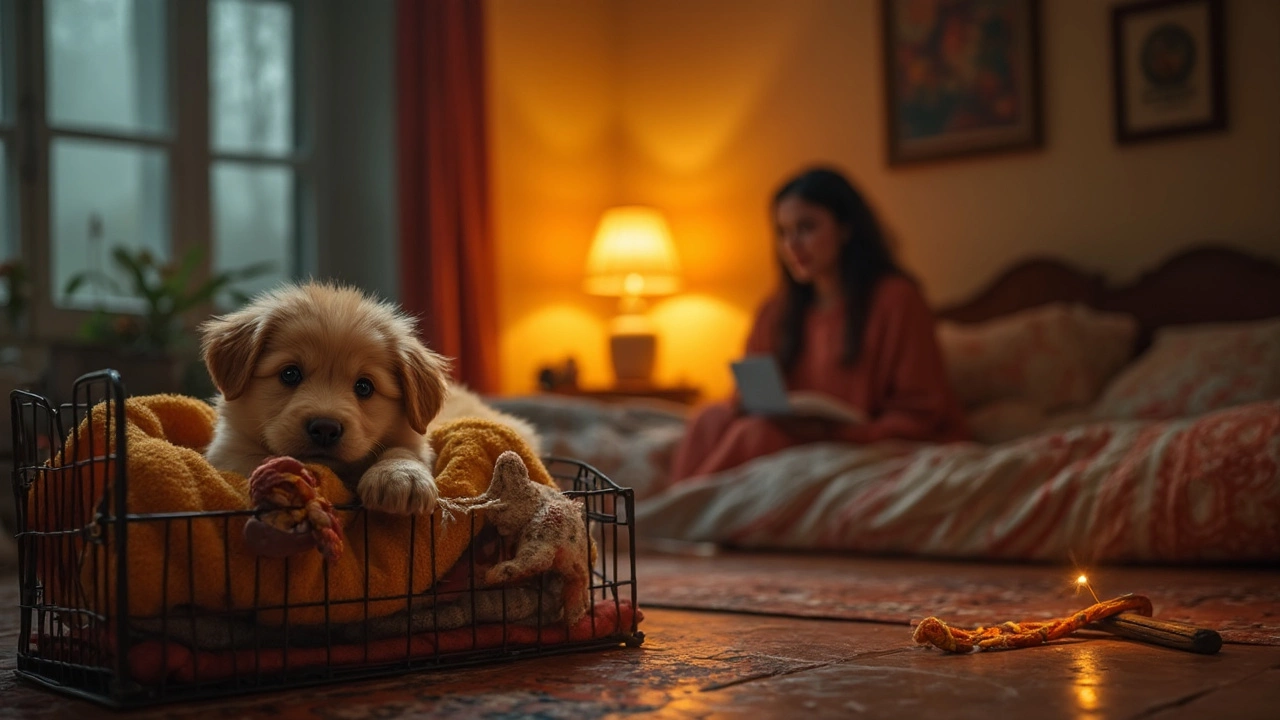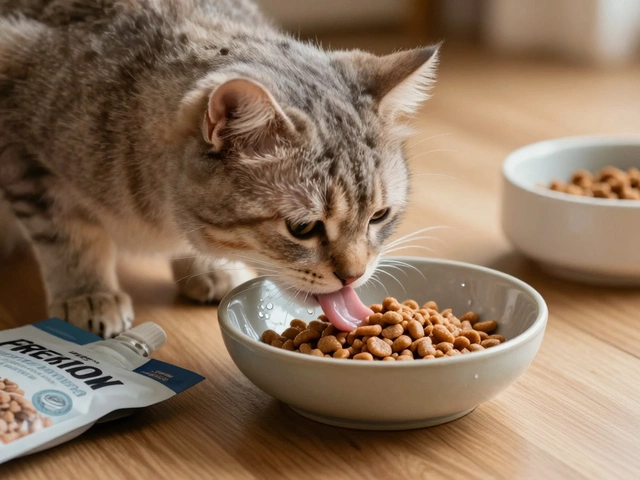
You just brought home a tiny tornado with fur, and now you’re staring at that puppy wondering: where should this little goof actually sleep tonight? Leaving it up to chance usually ends with you cleaning up pee or getting no sleep, so picking the right spot is a big deal—way more important than most folks think.
First thing to know: untrained puppies need a spot that’s safe, easy to clean, and makes them feel somewhat secure—not just for your sanity, but for the puppy’s comfort, too. Setting up a controlled area (like a crate or a puppy playpen) right from the start can help prevent accidents and teach routines, even if you’ve never done this before. Random sleeping spots like laundry piles or loose blankets in the living room? They'll turn into bathroom zones by 3 a.m. Trust me, puppies sniff out those spots like pros.
A common trick is to put the puppy’s crate or pen somewhere near where you sleep for the first few nights. This stops the barking and panic that starts when they suddenly realize, “Wait, where did everyone go?” With you close by, they’re less anxious and less likely to turn your night into a barking marathon. Investing a little effort in the right sleep setup saves you from a lot of sleepless nights and cleanup headaches down the line.
- Why Sleep Location Matters for Untrained Puppies
- Crate, Pen, or Bed: Comparing Sleep Setups
- How to Set Up a Safe Sleeping Area
- Dealing with Whining, Anxiety, or Restlessness
- What to Avoid: Common Sleep Mistakes
- Building Healthy Long-Term Sleep Habits
Why Sleep Location Matters for Untrained Puppies
Picking the right spot for your puppy sleep isn’t just about comfort; it shapes your puppy’s whole routine. Untrained puppies don’t control their bladders or understand house rules. If their sleep spot isn’t set up right, you’ll likely wake up to chewed shoes, soiled carpets, and a puppy that feels anxious or unsafe. That’s why your sleeping setup can really make or break those first few weeks.
The main thing is safety. An untrained puppy left to sleep anywhere—like a couch or adult dog bed—can easily get into trouble. Chewing cords or getting stuck behind furniture is way more common than you’d think. Puppies also look for places to pee that are far from their food and bed, so the “open floor” strategy means they’ll just pick their own bathroom spot, usually somewhere you don’t want it.
Security is another top reason. Dogs, even tiny ones, are den animals by nature. A crate or playpen mimics that “den” feel and gives your puppy a sense of security in a new home. There’s real science behind it: puppies kept in cozy, controlled spots are less likely to panic and whine overnight.
Consistent sleep spots are a huge help for puppy care and crate training. When your puppy learns exactly where bedtime happens, they start to catch on—"this is where I settle down"—instead of running around the house all night. Plus, it helps with house training; a contained space teaches the puppy to hold it in longer since almost all puppies avoid soiling where they sleep.
- Accidents drop by 60% when puppies sleep in crates or pens instead of open rooms (according to a 2023 survey by the AKC).
- Early routine-building helps cut down on behavior issues like separation anxiety later.
- Beds with too much freedom make nighttime whining and barking twice as likely compared to contained setups.
So, bottom line: choosing a smart puppy sleep location means fewer messes, happier routines, and a less stressed-out new puppy.
Crate, Pen, or Bed: Comparing Sleep Setups
Picking where your puppy sleep happens isn’t just a comfort thing—it’s a training move. Let’s break down your main options with real talk about what works, what backfires, and what actually fits your life.
- Crate: The crate’s the most popular pick, mostly because it doubles as a training tool. Dogs are hardwired not to mess where they sleep, so a crate can speed up potty training. Look for a crate that’s just big enough so your puppy can stand up and turn around. Too big, and accidents happen in the corners. Add washable bedding and a safe chew toy to make it feel like a mini home.
- Puppy Pen: Not everyone loves crates, and some puppies panic with closed doors. In those cases, a puppy playpen offers a bit more space. Toss in a small bed and pee pads for backup. Pens are great if you need to leave your puppy alone for a few hours since there’s room to play, nap, and do business if needed, but they aren’t as foolproof for crate training.
- Human Bed or Open Room: Letting an untrained puppy sleep in your bed or roam free sounds sweet until you wake up in the wet spot—or worse, can’t find the puppy. Most trainers say hold off on this until your dog is fully housebroken and follows a bedtime routine. Otherwise, your bed becomes their playground and potty spot all at once.
To see how common each setup is (and how well each one works), here’s what a 2023 survey of new dog owners reported:
| Sleep Setup | Success with Potty Training (First 2 Weeks) | User Satisfaction |
|---|---|---|
| Crate | 82% | High |
| Puppy Pen | 60% | Medium |
| Human Bed/Open Room | 21% | Low |
If you want a mix of safety and puppy care routine, crates usually come out on top. Pens are good backups if your puppy’s seriously crate-shy. Letting them loose before they’re trained? You’ll likely regret it. No matter which setup you go with, make sure it’s somewhere quiet at night—near you is best for those first few weeks. A nighttime routine grows way easier when your puppy feels safe and you know what to expect.
How to Set Up a Safe Sleeping Area
If you want your untrained puppy (and your floors) to make it through the night, setting up a proper sleeping area is a must. Puppies are curious, a little clueless, and will chew or pee on nearly anything within reach, so don’t just toss a blanket on the floor and hope for the best.
Start with picking the right spot. Choose a low-traffic area that’s not too isolated. Puppies get anxious if they’re shut away and can’t hear any signs of life, but they also need space that’s peaceful enough for sleep. A corner of your bedroom or a quiet nook nearby usually works well.
Here’s a step-by-step approach for getting the puppy sleep zone right:
- Use a crate or sturdy puppy playpen: It should be big enough for your puppy to stand, turn around, and lie down, but not so big that they’ll pee at one end and nap at the other. Crates help with housebreaking and keep your shoes and cables safe from midnight chomping.
- Choose safe bedding: Go for something washable and chew-proof. Old towels or special puppy beds work. Skip anything fluffy or with loose stuffing—a bored puppy will rip it apart and might swallow chunks.
- Remove choking hazards: No small toys, plastic bits, or anything your puppy could swallow. Even newspapers can become a snack for a teething pup.
- Fresh water? Not at night: Puppies that drink too much right before bed are more likely to have accidents. Take up the water bowl an hour before bedtime, but offer it all day long.
- Keep it cozy, but don’t overdo it: Some puppies like a blanket draped over part of their crate to create a "den" feeling. Make sure there’s enough airflow and it’s not too warm (puppies overheat fast).
A quick look at why many folks use crates or playpens for puppy care:
| Setup | Pros | Cons |
|---|---|---|
| Crate | Boosts house training, keeps puppy secure, easy to clean | Needs proper intro or can create anxiety |
| Playpen | More space, toys allowed, less confinement stress | Harder to house train, needs puppy-proofing |
| Bed on floor | Feels open, cost-free | Easy access to trouble, almost zero control |
Double-check that the area is draft-free and not near heaters or open windows. Puppies don’t regulate temperature well, especially if they’re under three months old.
Last tip: keep a favorite plush toy or an item with your scent in the sleeping spot. It helps settle young pups who miss their littermates, and it'll make the nighttime routine less stressful. Set this up right, and you’re halfway to painless puppy nights already.

Dealing with Whining, Anxiety, or Restlessness
It’s 2 a.m. Your untrained puppy has just started whining like you’ve locked them out of Disney World. Don’t panic—this is super common. Puppies are used to sleeping in a pile with littermates, so their first nights alone can be stressful. Most of the noise you’re hearing is about them feeling confused, scared, or needing the bathroom—not some deep personality flaw.
First thing: never punish a puppy for whining at night. They aren't trying to get on your nerves. Instead, try these practical steps:
- Keep the crate or sleep area close: For the first week or so, place their crate or pen in your bedroom or just outside the door. The familiar sounds—and even your breathing—really help them relax and settle faster.
- Stick to a routine: Puppies thrive on consistency. Take your pup out for a potty break right before bed, keep playtime calm, and always use the same cue word when it’s time to settle in for the night.
- Offer a comfort item: Tuck in a worn T-shirt or a puppy-safe stuffed animal. Your scent (or something familiar) can help a puppy feel like they aren’t totally alone. Some puppy beds can even be warmed up to mimic a littermate’s body heat.
- Don’t rush to respond: If you know your puppy doesn't need a bathroom break and isn’t stuck, give them a few minutes to settle. Constantly rushing in for every whimper can teach them that noise equals attention.
- Bathroom breaks matter: At 8 weeks old, most puppies can’t hold it all night. Plan for at least one quick bathroom break, quietly, with the lights low. No playtime—just business.
Here’s a quick look at typical nighttime puppy behavior and what it means:
| Noise | Possible Reason | Recommended Response |
|---|---|---|
| Constant whining + pacing | Might need a potty break | Quietly take outside, no extra stimulation |
| Short whine, then settles | Just bored or adjusting | Let them settle, don’t intervene |
| Barking or yelping nonstop | Anxiety or fear | Bring crate closer, add comfort item |
Stay patient. Most puppy sleep drama starts to fade after the first couple of weeks if you keep things clear and routine. Remember: Getting up a few times now can mean a calmer, more confident dog in the long run.
What to Avoid: Common Sleep Mistakes
Setting up your puppy sleep game can fall apart fast if you stumble into a few classic traps. Let’s cut through the trial and error and go over what not to do when setting up where your untrained puppy gets their shut-eye.
- No Free Roaming at Night: Letting your puppy wander the house while you sleep is asking for accidents and chewed-up things. Untrained puppies don’t know the rules yet, and your carpet will suffer for it.
- Avoid Soft, Fluffy Beds at First: Those plush beds look comfy, but puppies often chew and shred them or use them as a bathroom. Start with simple blankets or towels in a secure spot—something easy to wash and hard to ruin.
- Don’t Ignore Size: A crate or pen that’s too big encourages your puppy to use one corner as a toilet. The space should be just big enough for them to stand, turn around, and sprawl out comfortably.
- Skipping Late-Night Potty Breaks: Puppies can’t hold it all night, especially under four months old. Set an alarm for a quick nighttime potty break or be ready for middle-of-the-night accidents.
- Putting the Puppy Far From You: Shoving the crate in the garage or laundry room sounds tempting, but distance often leads to anxious whining. Keep your untrained puppy close—you’ll get more rest, they’ll feel safer, and you can quickly step in if they need something.
- Being Inconsistent: If you move your puppy’s sleeping spot every night, you’re confusing them and slowing down the whole training process. Stick to a routine so they learn what to expect.
Here’s a quick look at what dog trainers run into most often with new puppy owners:
| Common Mistake | Percent of Dog Trainers Reporting This |
|---|---|
| Letting puppies sleep loose in the house | 78% |
| Skipping nighttime potty breaks | 67% |
| Putting crate too far from sleeping area | 54% |
| Using soft beds too early | 43% |
By dodging these mistakes, you’ll make nights easier and help your puppy care routine stick much faster. Each night with less confusion is one step closer to a housebroken pup—and a full night’s sleep for you.
Building Healthy Long-Term Sleep Habits
If you want a happy, well-behaved dog later, you really can’t skip building good sleep habits when they’re little. It sets the whole tone for training, trust, and even how much you deal with sudden midnight barking or puddles in the hallway. Putting in the work early with your puppy sleep routine pays off for years.
First, keep things consistent. Dogs, especially puppies, thrive on routine. Pick a sleep spot—whether it’s a crate, pen, or dog bed—and stick to it every night. Moving your puppy all over the house only confuses them. They need to know exactly where it’s safe to chill and snooze. Around the same time each evening, start winding things down: less play, quieter activities, a bathroom break, and then straight to the sleeping spot.
- Crate Training: If you go with a crate, make it comfortable: soft bedding, a safe chew toy, no food or water overnight. Most trainers say this is the fastest way to avoid accidents because dogs naturally don’t want to go where they sleep.
- Nighttime Routine: Take them out for a potty break right before bed and first thing in the morning. Even older puppies can’t hold it all night when they’re new. Gradually, their bladder control will catch up, but sticking to a schedule really helps.
- No Big Reactions to Whining: When your puppy fusses at night, don’t rush in every single time. It teaches them that noise means attention—which quickly turns into learned 2 a.m. puppy concerts. Wait and see if they settle down. If they keep whining, a quick, quiet check for potty needs is fine—just don’t make it playtime.
- Security Items: Some puppies sleep better with a piece of clothing that smells like you. It helps beat separation jitters and can make the crate or bed feel like home faster.
Here’s a quick look at how much sleep untrained puppies usually need as they grow. Keeping the schedule age-appropriate stops a lot of nighttime issues before they start:
| Puppy Age | Daily Sleep Need |
|---|---|
| 8-10 weeks | 18-20 hours |
| 3-4 months | 16-18 hours |
| 5-6 months | 14-16 hours |
Keep things calm at night—no late-night wrestling matches, loud noises, or new toys right before bed. Overstimulated puppies have a hard time winding down, which leads to restless, broken sleep and cranky mornings for everyone.
The cool thing? Good nighttime routine habits stick as they grow. You’ll spend way less time dealing with chewed shoes, indoor accidents, or midnight wake-ups, and a lot more time just enjoying your dog. Set the routine now and it’ll last a lifetime.



